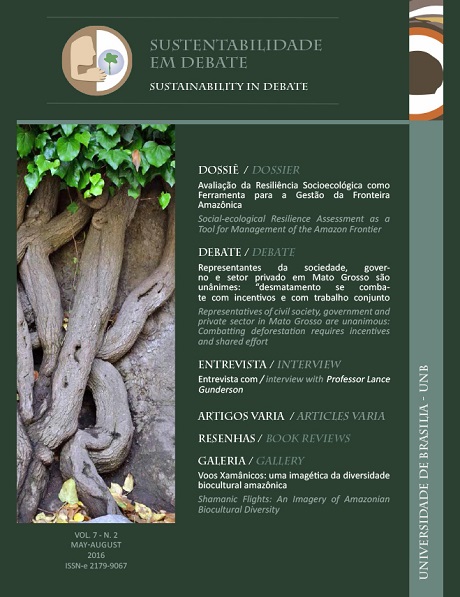Avaliação da Resiliência como ferramenta para entender a fronteira amazônica como um sistema socioecológico
DOI:
https://doi.org/10.18472/SustDeb.v7n2.2016.15134Palavras-chave:
Resiliência, Sistemas socioecológicos, Fronteira Amazônica, Avaliação da Resiliência, Fatores Desencadeantes, Atributos, CenáriosResumo
Este artigo apresenta o pensamento de resiliência e uma metodologia para avaliação desta que consiste
em definir o sistema (pergunta-chave e limites do sistema no tempo e no espaço); olhando para
a história (linha do tempo, fatores desencadeantes e interações entre escalas); especificando a resiliência
“do que” e “contra que” (definição de atributos e variáveis); cenários (prováveis fatores desencadeantes
futuros e possíveis regimes futuros desejáveis e indesejáveis); e desenvolvimento de
considerações de gestão para promover cenários desejáveis. A avaliação de resiliência de três grandes
grupos sociais do município de Cotriguaçu em Mato Grosso, Brasil ”“ proprietários de terras médias e
grandes, os povos indígenas Rikbaktsa e agricultores familiares ”“ revelou que cada grupo social passou
por várias iterações do ciclo adaptativo (crescimento-colapso-reorganização), e que a dinâmica desse
sistema é em grande parte determinada por fatores econômicos e políticos que vêm de uma escala maior. Contribuições para a metodologia de avaliação de resiliência incluem basear a análise do sistema
em sua trajetória histórica, procurar incorporar explicitamente as perspectivas dos atores locais, e
usar a análise de cenários para desenvolver possíveis intervenções de gestão.
Downloads
Referências
Indígena Escondido, Mato Grosso, Brasil. Sustentabilidade em Debate, 2016.
ANDERIES, J. M.; WALKER, B. H.; KINZIG, A. P. Fifteen weddings and a funeral: case studies and resilience-based
management. Ecology and Society 11(1): 21, 2006. [on-line] Available at: <http://www.ecologyandsociety.org/
vol11/iss1/art21/>.
ATHAYDE, S. et al. Aprendizagem colaborativa, transdisciplinaridade e gestão socioambiental na Amazônia: abordagens para a construção de conhecimento entre academia e sociedade. Revista Brasileira de Pós-Graduação, 10(21): 729-756, 2013.
BABY, A. L. T. Estudo da Dinâmica de Desmatamento do Município de Cotriguaçu ”“ MT. Trabalho de Conclusão de Curso apresentado à Universidade do Estado de Mato Grosso, no curso de Pós-Graduação Lato Sensu em Gestão Colaborativa de Sistemas Socioecológicos Complexos na Amazônia Brasileira, 2012.
BARNES, G.; CHILD, B. Conclusions, p. 283-300. In: BARNES, G.; CHILD, B. (Ed.). Adaptive Cross-scalar Governance of Natural Resources. Routledge. 2014.
BARTELS, W. L. et al. Who counts resilience and whose resilience counts? Reflections on applying the Resilience Assessment Workbook along a contested Amazonian frontier. Sustentabilidade em Debate, 2016.
BERNASCONI, P. et al. Avaliação da Resiliência do Sistema de Médios e Grandes Proprietários Rurais de Cotriguaçu (MT, Brasil). Sustentabilidade em Debate, 2016.
BRITO, B.; BARRETO, P. A regularização fundiária avançou na Amazônia? Os dois anos do Programa Terra Legal. Belém-PA: Imazon, 2011.
BROWDER, J. O. et al. Revisiting theories of frontier expansion in the Brazilian Amazon: a survey of the colonist farming population in Rondonia’s post-frontier, 1992-2002. World Development, 36(8), 1469-1492, 2008.
CARPENTER, S. R. et al. From metaphor to measurement: resilience of what to what? Ecosystems 4: 765-781, 2001.
DAVIDSON, E. A. et al. The Amazon basin in transition. Nature 481, n. 7381: 321-328, 2012.
FEARNSIDE, P. M.; LAURANCE, W. F. Infraestrutura na Amazônia: as lições dos planos plurianuais. Caderno CRH 25, n. 64: 87-98, 2012.
FOLKE, C. Resilience: The emergence of a perspective for social ecological systems analyses. Global Environmental Change 16(3): 253-267, 2006.
GOFFMAN, E. Frame analysis: An essay on the organization of experience. Harvard University Press, 1974.
HOLLING, C. S. Resilience and stability of ecological systems. Annual Review of Ecology and Systematics 4: 1-23, 1973.
HOLLING, C. S.; GUNDERSON, L. H. Resilience and adaptive cycles, p. 25-62. In: GUNDERSON, L. H.; HOLLING, C. S. (Ed.). Panarchy: understanding transformations in human and natural systems, Washington: Island Press, 2002.
HOLLING, C. S.; MEFFE, G. K. Command and control and the pathology of natural resource management. Conservation Biology, 10: 328-337, 1996.
ICV. Mato Grosso apresenta programa-piloto de REDD em Copenhague, 2009. Available at: <http://www.icv.org.br/site/2009/12/15/mato-grosso-apresenta-programa-piloto-de-redd-em-copenhague/>.
Accessed Mar 10, 2015.
LENTINI, M. W. (Coord.). Diagnóstico do Setor Florestal de Cotriguacu, Estado de Mato Grosso. Relatório Final. 2010. Available at: <http://www.icv.org.br/site/wp content/uploads/2013/08/10437relatorio_florestal_cotriguacu_
ift_icv.pdf>. Accessed Mar 10, 2015.
LEVIN, S. A. Self-organization and the emergence of complexity in ecological systems. Bioscience 55, n. 12: 1075-1079, 2005.
LITTLE, P. Amazonia. Territorial Struggles on Perennial Frontiers. The Johns Hopkins University Press, Baltimore and London. 2001.
LIU, J. et al. Complexity of coupled human and natural systems. Science, 317(5844): 1513-1516, 2007.
MACEDO, M. N. et al. Decoupling of deforestation and soy production in the southern Amazon during the late 2000s. Proceedings of the National Academy of Sciences 109, n. 4: 1341-1346, 2012.
MAIA, H. et al. Avaliação do Plano de Prevenção e Controle do Desmatamento na Amazônia Legal: PPCDAm: 2007-2010. 2011. Available at:
<http://repositorio.ipea.gov.br/bitstream/11058/884/1/IPEA_GIZ_Cepal_2011_
Avaliacao%20PPCDAm%202007-2011_web.pdf>. Accessed on Mar 10, 2015.
NEPSTAD, D. et al. The End of Deforestation in the Brazilian Amazon. Science, v. 326, n. 5958 p. 1350-1351, 2009.
NEVES, E. M. S. C. Política ambiental, municípios e cooperação intergovernamental no Brasil. Estudos Avançados, 26(74): 137-150, 2012.
OJEDA, I. Reforma agrária perde fôlego na agenda nacional. Desafios de Desenvolvimento, 75. IPEA. 2012. Available
at: http://www.ipea.gov.br/desafios/index.php option=com_content&view=article&id=2866:catid=28&Itemid=23>. Accessed on Mar 10, 2015.
OLIVAL, A. 2016. A resiliência em assentamentos rurais: uma experiência na região norte de Mato Grosso. Sustentabilidade em Debate, 2016.
PETERSON, G.; CUMMING, G.; CARPENTER, S. Scenario planning: a tool for conservation in an uncertain world. Conservation Biology, 17: 358-366, 2003.
REDMAN, C. L.; GROVE, J. M.; KUBY, L. H. Integrating social science into the long-term ecological research (LTER) network: social dimensions of ecological change and ecological dimensions of social change. Ecosystems, 7(2): 161-171, 2004.
RESILIENCE ALLIANCE. Assessing Resilience in Social-Ecological Systems: A Workbook for Practitioners, Version 1.1, 2007a.
RESILIENCE ALLIANCE. Assessing resilience in social-ecological systems: Workbook for practitioners. Version 2.0. 2010. [On-line]
Available at: <http://www.resalliance.org/files/ResilienceAssessmentV2_2.pdf>. Accessed on Jul 19, 2016.
RESILIENCE ALLIANCE. Assessing Resilience in Social-Ecological Systems: A Workbook for Scientists, Version 1.1 2007b. [On-line]
Available at: <http://library.uniteddiversity.coop/Transition_Relocalisation_Resilience/resilience_workbook_for_scientists.pdf>. Accessed on Jul 19, 2016.
SCHMINK, M.; WOOD, C. H. Contested Frontiers in Amazonia. Columbia University Press, New York, 1992.
SIMÃO, B.; ATHAYDE, S. Resiliência socioecológica em comunidades deslocadas por hidrelétricas na Amazônia: o caso de Nova Mutum Paraná, Rondônia. Sustentabilidade em Debate, 2016.
SIMMONS, C. et al. Doing it for themselves: direct action land reform in the Brazilian Amazon. World Development 38(3): 429-444, 2010.
SOBREIRO, T. Dinâmica Socioecológica e Resiliência da Pesca Ornamental em Barcelos, Rio Negro, Amazonas, Brasil. Sustentabilidade em Debate, 2016.
STRICKLAND-MUNRO, J. K.; ALLISON, H. E.; MOORE, S. A. Using resilience concepts to investigate the impacts of protected area tourism on communities. Annals of Tourism Research, 37(2), p.499-519, 2010.
TURNER, F. J. The Significance of the Frontier in American History. Report of the American Historical Association for 1893, 199-227, 1893.
WALKER, B.; SALT, D. Resilience thinking: sustaining ecosystems and people in a changing world. Island Press, 2012.
WALKER, B. H. et al. Resilience, adaptability, and transformability in the Goulburn-Broken Catchment, Australia. Ecology and Society, 14(1), p.12, 2009.
VAN DER HEIJDEN, K. Scenarios: the art of strategic conversation. John Wiley & Sons, 2005.
VERISSIMO, A. et al. Áreas Protegidas na Amazônia Brasileira: avanços e desafios. Belém/São Paulo: Imazon and ISA, 2011.
Downloads
Publicado
Como Citar
Edição
Seção
Licença
A submissão de trabalho(s) científico(s) original(is) pelos autores, na qualidade de titulares do direito de autor do(s) texto(s) enviado(s) ao periódico, nos termos da Lei 9.610/98, implica na cessão de direitos autorais de publicação impressa e/ou digital à Revista Sustentabilidade em Debate do(s) artigo(s) aprovado(s) para fins da publicação, em um único número da Revista, autorizando-se, ainda, que o(s) trabalho(s) científico(s) aprovado(s) seja(m) divulgado(s) gratuitamente, sem qualquer tipo de ressarcimento a título de direitos autorais, por meio do site da Revista, para fins de leitura, impressão e/ou download do arquivo do texto, a partir da data de aceitação para fins de publicação. Portanto, os autores ao procederem a submissão do(s) artigo(s) Revista, e, por conseguinte, a cessão gratuita dos direitos autorais relacionados ao trabalho científico enviado, têm plena ciência de que não serão remunerados pela publicação do(s) artigo(s) no periódico.
A Revista encontra-se licenciada sob uma Licença Creative Commons Atribuição-NãoComercial-SemDerivações (Proibição de Realização de Obras Derivadas) 3.0 Brasil, para fins de difusão do conhecimento científico, conforme indicado no sítio da publicação, que permite o compartilhamento do texto e o reconhecimento de sua autoria e publicação original nesta revista.
Os autores têm permissão para assumir contratos adicionais separadamente, para distribuição não-exclusiva dos trabalhos publicados na Revista Sustentabilidade em Debate (por exemplo, em um capítulo de livro), desde que seja assinalado que os textos foram originalmente publicados nesta revista e que seja mencionado o DOI correspondente. Os autores têm permissão e são estimulados a publicar e distribuir o seu texto online, após a publicação (por exemplo, em repositórios institucionais ou nas suas páginas pessoais).
Os autores declaram expressamente concordar com os termos da presente Declaração de Direito Autoral, que se aplicará a submissão caso seja publicada por esta Revista.






